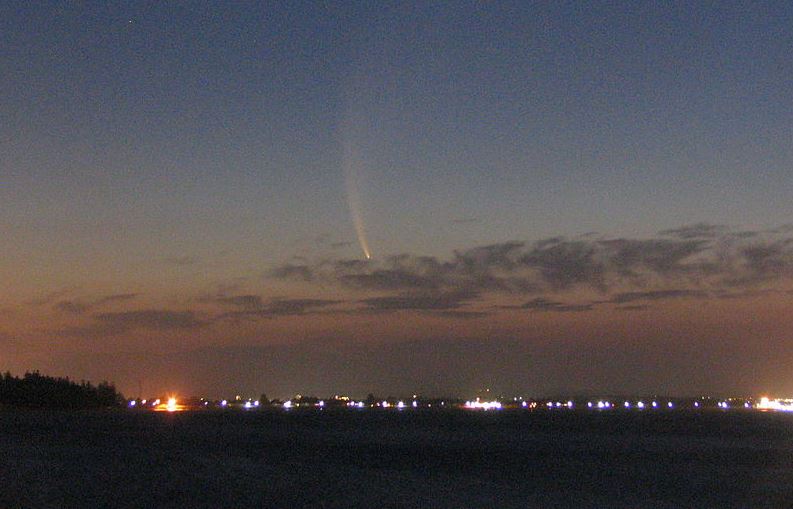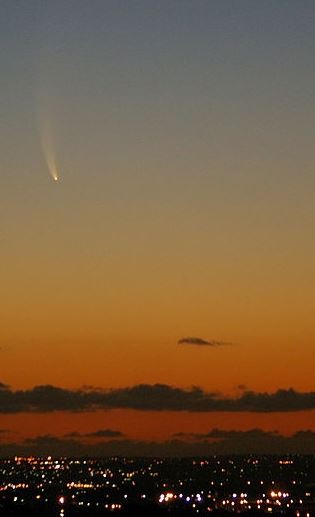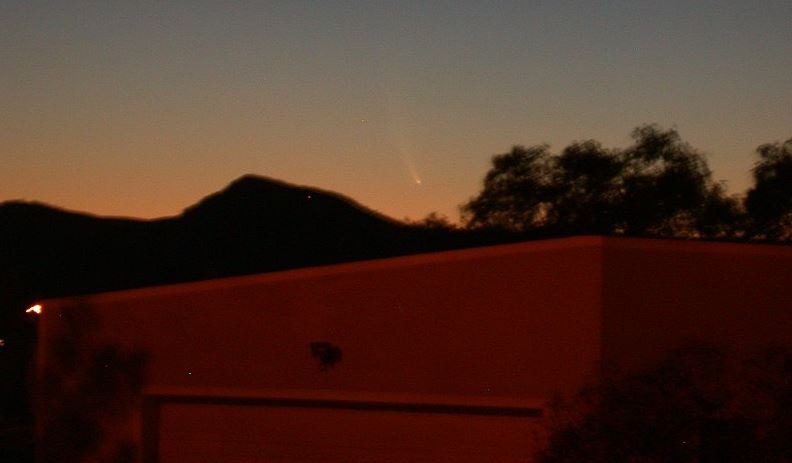Comet discoveries are always unexpected and astonishing. Finding a new celestial object in our solar system indicates that there is a possibility of various new aspects that we can find out about our solar system. However, comet discoveries are neither frequent nor easy to spot despite the better technology. One of the greatest comets in the 21st century ever observed from Earth has been Comet McNaught. It was known to be the brightest comet in over 4 decades.
Overview of Comet McNaught
Comet McNaught was discovered in 2006 by the British-Australian astronomer Robert H. McNaught. The exact date of discovery of this comet is 7th August 2006 and was discovered using the Uppsala Southern Schmidt Telescope. The official name of this comet is C/2006 P1 and has been observed as a non-periodic comet. The comet had a high magnitude of -5.5 which made it the brightest comet in 40 years. The comet had its perihelion on 12th January 2007 which was easily visible during the daytime at this time.
By the time the comet reached the perihelion, its distance from the sun was only 0.17 astronomical units. The comet had a tail with a high length of 35 degrees. Being a non-periodic comet, there aren’t any chances that we will be seeing it again. However, there were quite many interesting facts regarding this comet which led to it being one of the most popular comets ever seen in our solar system. During its last appearance in January and February 2007, the comet’s tail displayed a fan-like structure.
Discovery of Comet McNaught
Robert McNaught was just observing the Near-Earth Objects that could be on a collision course with the Earth or any other possible threat. On 7th August 2006, he discovered the comet in a CCD image. By this time, the comet had a very dim light with a magnitude of -17. Upon discovery, McNaught informed the Central Bureau for Astronomical Telegrams in which it was confirmed that this was a new comet never seen before.
The discovery of this comet surprised many astronomers as it was visible from quite a distance and was going to come quite close to Earth as well. The scientists also observed that this comet will have a huge tail and a high magnitude as well as it would reach closer. Initial discoveries of this comet also concluded that it had a Jupiter Minimum Orbit Intersection distance of 0.32 astronomical units. Some studies also showed that the inbound orbital period was around 6 million years while the outbound orbital period was around 92,600 years.
Post-Discovery Timeline of Comet McNaught
Over the next few months, it was apparent that the comet was coming close to the sun as a part of its orbit. From August to November 2006, the comet was constantly tracked by astronomers at NASA as well as other astronomical organizations. During this time, the magnitude increased to 9 but was still not bright enough to be seen with the naked eye. In December 2006, the comet disappeared from view because it was in the glare of the sun.
In January 2007, the comet was once again visible and this time, it was brightening even faster. The first naked-eye visibility was observed during the first 10 days of January 2007 when Comet McNaught was visible in the Northern Hemispheres. On 12th January 2007, the comet reached the perihelion and was observed by spacecraft as well. The Solar and Heliospheric Observatory was able to observe this comet from a closer angle. Therefore, the comet was easily viewable on the web in real-time.
Due to its high brightness observed in 40 years, it was given the title of “The Great Comet of 2006”. By 15th January 2007, the comet was closest to Earth with a distance of 0.82 astronomical units. After passing the sun, the comet was visible in the Southern Hemisphere for quite some time after which it started to fade, and then completely disappeared.
Observations of Comet McNaught
While there were many observations of Comet McNaught from Earth, things took an unexpected turn when a spacecraft named Ulysses also made a close pass to the comet. On 3rd February 2007, the comet passed through the tail of McNaught at a distance of 250 million kilometers from the core of the comet. Observations from the data retrieved from Ulysses spacecraft showed that there were various forms of complex chemical compositions in the comet.
A few unusual ions were detected on McNaught’s tail. Oxygen Ions O3+ were detected in the tail of the comet. It implied the fact that solar ions gained some electrons as they passed through the atmosphere of the comet.
The spacecraft and satellites that orbit the Earth also provided observations that the comet was quite big. Spacecraft Ulysses took 18 days to traverse the shocked solar wind from the comet. The Giotto spacecraft also took several hours to cross the shocked region from the comet which showed the massive size and immense energy being carried by the comet. Due to the huge size of the comet, researchers also found evidence of a shockwave surrounding the comet.
Another shocking observation of this comet was the speed of solar wind which slowed down to almost half the regular speed. It was quite surprising for many to find out that this happened 260 million kilometers from the nucleus of the comet and not even that close to the comet. Solar winds usually travel at speeds of 700 km/s at that distance but the comet’s ionized tail reduced the speed to less than 400km/s. Micheal Combi, an astronomer, suggested that this is such a unique phenomenon that physicists will find it difficult to work out the physics behind this occurrence. Even the computer models would find it difficult to calculate the physics in this speed distortion.
Professor George Gloeckler who was the principal investigator on the Solar Wind Ion Composition Spectrometer suggested that this was an important discovery. It showed the composition of comets and suggested the possible chemical conditions of the time when the solar system was formed around 4.5 billion years ago. However, as this comet is a non-periodic one, any further observations could not be made on this comet.
About the Discoverer – Robert McNaught
Robert McNaught is a Scottish-Australian astronomer who was born in 1956. His major contribution to the field of astronomy is the discovery of Comet McNaught in 2007 as well as discovering the main-belt asteroid named 3173 McNaught. In total, McNaught has discovered a total of 82 comets with his last discovery being in 2013. Due to his frequent discoveries of comets as well as various other celestial objects, he is named “the world’s greatest comet discoverer” to date. McNaught has also worked on the Anglo-Australian Near-Earth Asteroid Survey held between 1990 and 1996.
Conclusion
Comet McNaught was discovered in the early 2000s and till now, it is described as the brightest comet noticed in the 21st century. Due to the big size of this comet, it was apparent in various parts of Australia and people spotted this comet easily. The unique chemical compositions as well as the presence of ions in the tail of this comet is a phenomenon that many astronomers have not been able to figure out fully. Apart from that, the shockwave presence and reduction in the speed of solar winds is also a phenomenon not yet uncovered by astronomers. It was one of the most iconic events in Space exploration.




